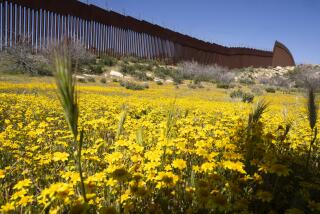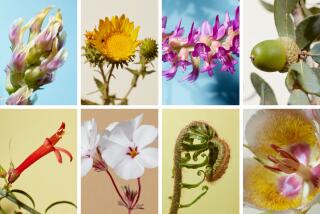Experiment Shows Diverse Plant Life Is Good for Planet
- Share via
EAST BETHEL, Minn. — William Cooper leaned through the door of a tiny airplane in 1930 and looked down on a patchwork of forest, bog and prairie. Even from that height, he recognized the promise of the unusual collection of ecosystems.
He didn’t, however, do a very good job of remembering its location. The pioneering ecologist and other researchers spent years before they figured out where it was and acquired the land. They gave it to the University of Minnesota in 1942.
Since then, researchers have done more than 100 experiments on its nine square miles in an effort to understand the nation’s ecosystems.
“All the major ecosystems in the [northern] states are here; we can get information for the ecosystems from the Rockies to Maine,” said David Tilman, who directs the Cedar Creek Natural History Area, one of the most studied pieces of ground.
The diverse terrain, 30 miles north of the Twin Cities, includes a rare oak savanna, and spruce and pine forests. The Cedar Creek wetlands snake across it. There’s a bog, a lake and fallow farm fields.
Tilman, an ecologist at the university, said researchers began work by recording information about the area’s plants, insects and animals. As a result, researchers have a baseline of information on the environment.
Experiments have yielded a steady stream of papers in prominent scientific journals. Topics include the effects of forest fires, nitrogen pollution and benefits of biological diversity.
In one experiment, Tilman and his colleagues planted a field in a checkerboard of different combinations of wild plants. They found that plots with more kinds of plants were more productive and hardier than plots with smaller combinations.
Research also shows broad mixes of native plants absorb more carbon dioxide, make better use of nutrients, are more resistant to disease and resist invading species better than a single species on its own.
The results have global implications because humanity has altered ecosystems by reducing diversity and introducing foreign plants. The catalyst has been the massive addition of carbon dioxide and nitrogen into the air and soil, Tilman said. Nitrogen in the soil prompts tremendous growth in some species, which choke out others. Carbon dioxide and nitrogen enter the air from burning fossil fuels, but most nitrogen in the ground is from fertilizer.
Tilman’s colleague at the university, Peter Reich, is conducting an experiment that examines how plants react to increased nitrogen and carbon dioxide. It is called BioCon -- for biodiversity, carbon dioxide and nitrogen.
White plastic pipes form a fence around six large rings of plants. Inside the rings, he has planted and divided different combinations of plants. Reich and his students fertilized some plots with nitrogen while the pipes vent carefully regulated amounts of carbon dioxide over the rings.
“This experiment is a time machine of a sort,” Tilman said.
Reich said that since the experiment started in 1998, he has found that plots with the most diverse group of plants absorb more carbon dioxide, which is harmful to people, than plots with fewer plants.
The results so far suggest that highly diverse ecosystems will do a better job of turning carbon dioxide into oxygen than less-diverse ecosystems.
Tilman’s experiments have brought scientific rigor to environmental debates, said Laura Huenneke, chairwoman of the biology department at New Mexico State University.
“Ecology has this reputation for running about in the streets shouting alarm about the negative impacts of losing species and diversity reduction, but we’ve been shockingly remiss in supplying any hard experimental data to demonstrate the environmental impact,” she said.
“Dave Tilman has certainly been at the forefront of those who have pushed for careful experimentation as a direct attack on this question,” she said.






